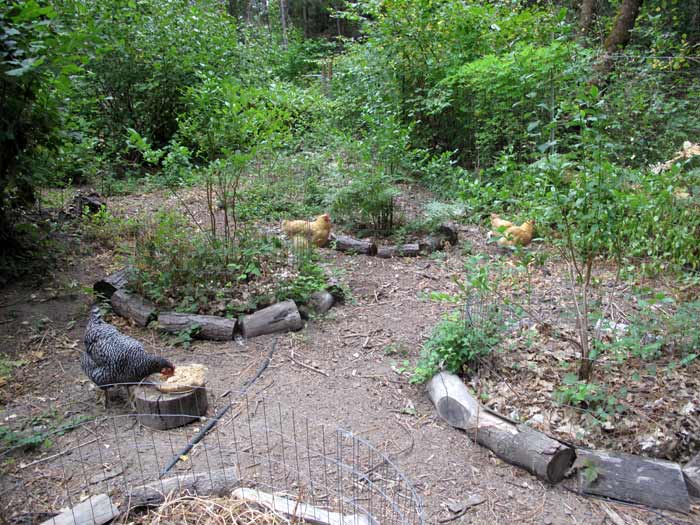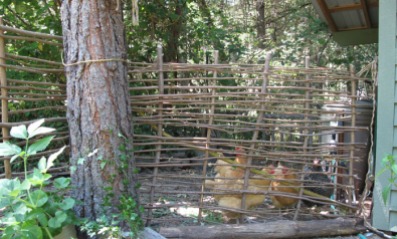
Back in 1982 I discovered quite accidentally, at a place we had just moved to, that chickens can make the most wonderful compost! It rains a lot in the Portland area, and the small pen had no cover so it would be a muddy mess for 7 or 8 months of the year. I decided to keep the ground covered with straw. Through that first winter I spread fresh straw when it needed it, and the hens merrily pooped and scratched away at the straw, and at the weeds and veggie scraps I threw in for them. In July when things dried out and I felt a need for some mulch in my garden I turned to what was by then a 6” layer of compost in the chickens pen! Wheelbarrow after wheelbarrow of the most wonderful fluffy dark rich stuff went on to my garden beds. Anything I spread it around grew amazingly well!
Ever since then chickens have been my go-to compost makers.

I know that most people keep chickens for the eggs they give. But a hen will only lay well for 3 or 4 years and spottily for a couple more. Other people raise them to eat. And I honor that. I eat chicken, but not ones that I have raised myself. I have chickens because of their poop. And the compost they create out of the straw I put in their pen. They may quit laying eggs after a few years but they never quit pooping and scratching! I love having an ongoing, never-ending supply of a rich high nitrogen fertilizer and compost for my garden, made by experts!

Because I eat the eggs they lay and because what is in their feed makes it into into those eggs as well as their poop, which then makes it into the food I grow using that poop in my garden – I feed them the best food I can manage. The last three years I have fed them sprouted organic grains and seeds. I feed them a mix of organic black oil sunflower seed, red winter wheat, oat groats, whole barley, buckwheat, millet and lentils. I listed these in the order in which the chickens seem to prefer them. They always snatch the sunflower seeds first and the millet and lentils they only eat as a last resort.

There are three advantages to sprouting the seed (which I figure takes me all of 5 min. a day); the first is that sprouting seed increases the nutrient level in the seed several times over, secondly, it reduces “anti-nutrients” and phytic acid – making the grains more digestible. The third advantage is monetary – soaking and sprouting more than doubles the size of the grain – so I feed much less than I would if it were not soaked and sprouted. Those are three strong enough incentives to get me rinsing 3 half gallons jars of grains and seeds once a day (in a 3 day cycle) – which, as I said takes me about 5 minutes.

I also raise Azolla for my girls (and for compost and mulch). Azolla is a most amazing floating water plant – similar to duckweed. It is really a perfect plant for a closed loop system, since it needs only shallow water to grow in and very little in the way of added nutrients. It pulls nitrogen from the air and minerals from the water. It’s a high quality, digestible, high protein (25-35%!) food and my hens love it! They have eaten it since they were young chicks. Judging from what I have read online, here and here, it can replace about 20% of their feed. I put it in a plastic dishpan full of water for them so it stays fresh all day.

One of the beauties of Azolla is that it will double in volume every three days. I can scoop a bucket full out of the pond every morning in the summer. Anything extra I just put around plants as a mulch or mix in to the soil as I plant new starts. The high nitrogen is great for plants too and is very bio-available.
It survived every winter here so far, but if I lived somewhere really cold I would put a bucket somewhere warm where it got sunlight – or in a larger plastic tub – so I would have some to feed through the winter as well. I put in a 21′ x 15′ frog pond this spring so I could grow more of the stuff since it’s so useful and easy to grow.

A third thing I have done for the “girls”, because they don’t have access to the garden, is to grow two beds of greens in their pen. And lots of greens in the garden year round which I pick for them every day. They love Swiss chard and comfrey best, and happily eat kale, collards, broccoli leaves, borage, wild miner’s lettuce, chickweed, dandelions, clover and alfalfa (which is easy to grow and pretty!). I usually grow grass in the beds in the pens because it’s a favorite food and with the beds covered with chicken wire they can’t trample or scratch it up. (See the pictures below). So all year round they have fresh greens to eat.

Their favorite food of all is earthworms and bugs. So, every fall I haul huge tarps full of oak leaves into the fenced off wild Hazelnut/Blueberry grove where they spend most of their days. Worms and creepy crawlies just love piles of wet leaves! All winter long the girls scratch around in that thick layer of leaves finding “goodies” to eat, and by spring it has all become well manured compost to feed the hazelnuts and blueberries! That’s a lovely free and easy closed loop system that works really well here. I protect the blueberry plants from enthusiastic hen scratching with a short wire fence cage and chunks of firewood around the edge. The wild Hazelnut trees supply shade and protective cover for the hens, along with nuts (when I can beat the Jays to them!), and material for my wattle fence and gate that will one day replace the deer netting fence there now. I also make all sorts of odds and ends with the prunings.

I planted an everbearing Mulberry tree in the middle of all this in the hopes of luring birds away from the nearby cherry tree when it starts bearing – and to feed the chickens when the mulberries fall from the tree. I recently discovered how really yummy the berries are, so the girls will have some competition from me as well!
There is also wild Oregon trailing blackberry growing in this area that the chickens have not managed to dig up. Probably has to do with the dainty thorny stems – or maybe this blackberry is just too tough for a chicken to kill… It has proven too tough for me! But they enjoy the little sweet berries in the summer, so I only hack it back every other year or so.
Are chickens worth the work? There are lots of different ways of having chickens, many that are lots less work than my way. But they are worth it for me. I happen to really LIKE chickens. I love the way Sally always comes to tell me the latest chicken gossip when I am working in the pen – chattering away softly whenever I am around. And the way they all murmur soft little good nights when I close them in for the night and wish them “sweet chicken dreams”. I loved watching Maude raise a little batch of chicks that I got for her for Mother’s Day last year. She is my “broody” hen and had been trying to be a mama for 2 years. She was so proud and was such a good mother! So – at the end of the day – I’d have to say” Yeah, I’m really glad to have a few hens in my life…”
*Sidenote: If you click on one of the pictures in the gallery it will do a slide show of full sized pictures (just in case you didn’t know… )






[…] Source: Feeding my chickens… | The Holistic Garden […]
LikeLike
Great article. So many new ideas for my chickens. Thanks you.
LikeLike
Thanks Pauline. I’m glad you got some inspiration from it!
LikeLike